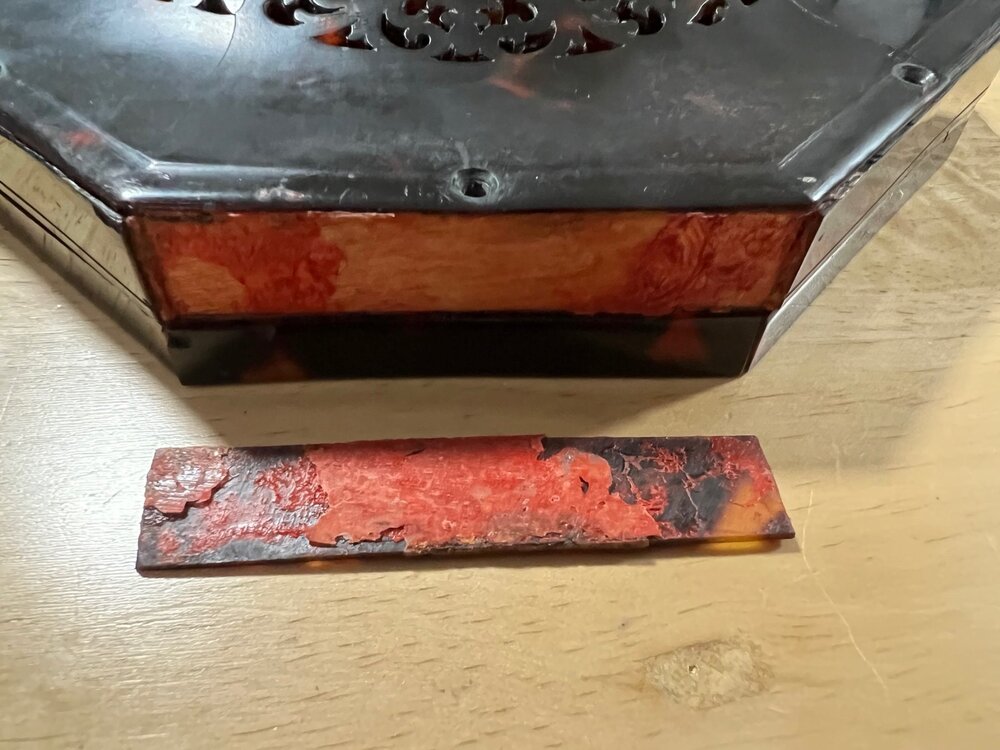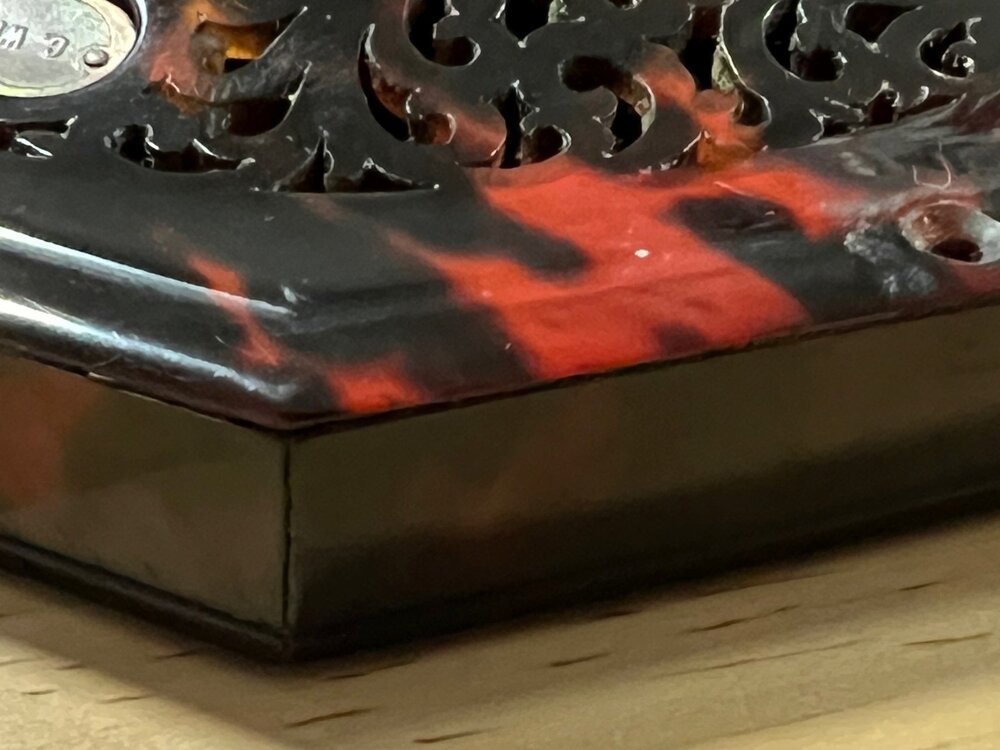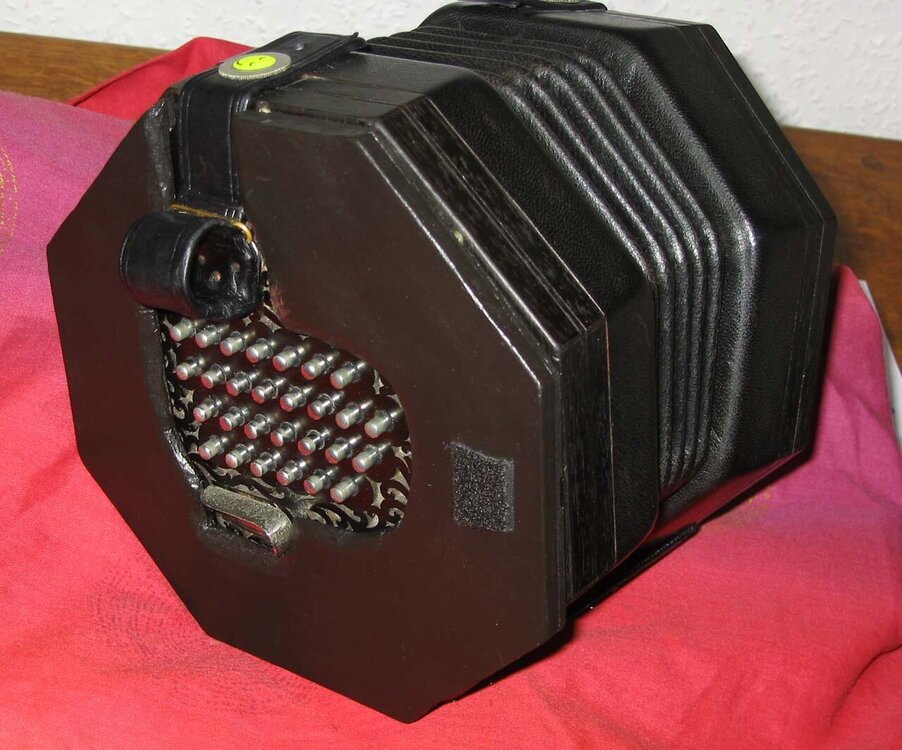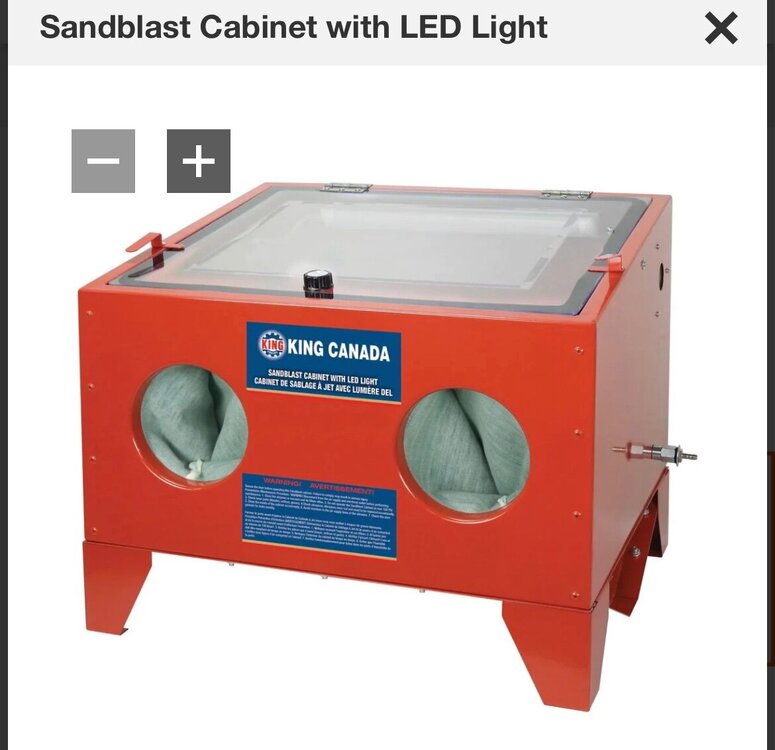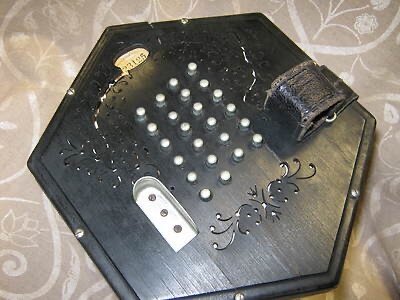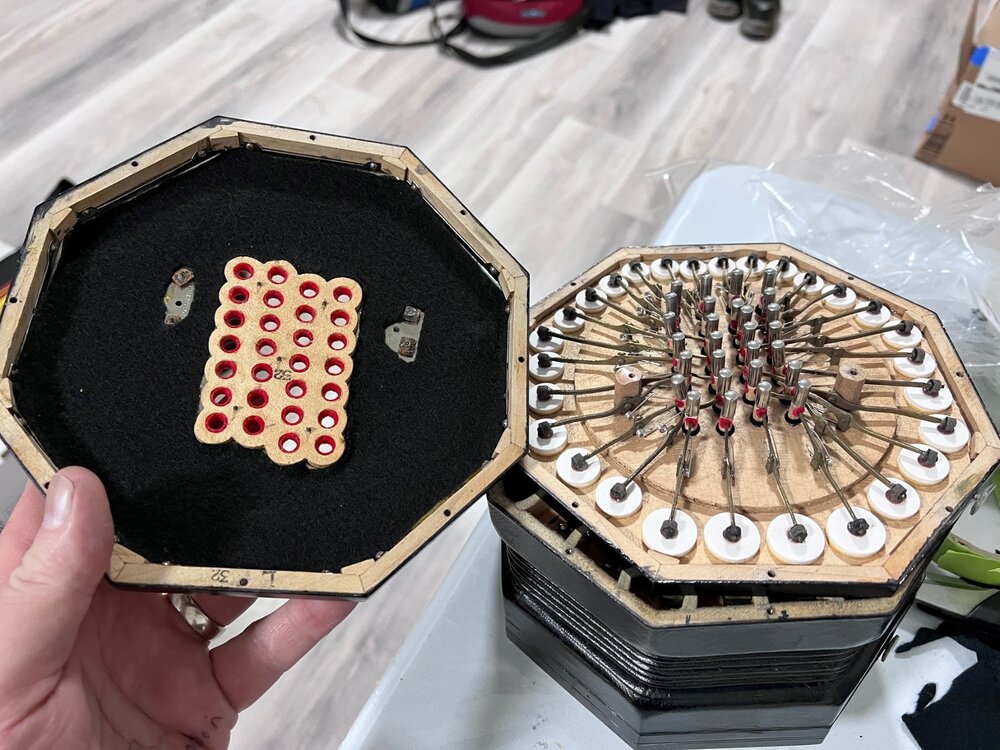-
Posts
296 -
Joined
Everything posted by 4to5to6
-
Thanks Chris. Please point me to where the photos are posted.
-
Seems to be hide glue mixed with a red dye. It's interesting to see how different torts look. I am not a big fan of this red look but my wife loves it! I am 90% sure that this one is not hawksbill turtle shell but it was a challenge to tell the difference (I have some genuine hawksbill to compare it with). Even burn test was not conclusive. It "somewhat" smelled like hair but not as strong and smoldered, rather than melted similar to real shell... close to real shell but not conclusive either way. The real turtle shell has a very strong burnt hair smell but this one didn't smell like plastic, unless maybe Bakelite, thermosetting plastic. Next test is under the microscope as real tort pigment looks like tiny dots.
-
Very nice Fred! I also do anything and everything it takes to make it "swing"! It is dance music after all. Bellows direction changes has a distinct sound or "articulation". I shake it, bump it :), pop the notes... Not every instrument can do a dynamic swell. I see the points about the wrist straps but find them quite restrictive when playing harmony notes. Interesting concertina with some high note buttons missing.
-
Did Wheatstone ever make white concertinas? I'm curious about this one... I've seen photos of gold, red and even yellow ones over the years... Please examine the photos. This is an early 20s Aeola English Baritone Treble. It appears to be a 56 key model but there is no model number in the ledger, only "N.P. octo Bar Treb". In my limited experience this would possibly make it a "special" but nothing seems to be unusual. Then I thought about the finish... I've never seen an undercoating like this before as can be seen where the finish is worn through and this appears to be factory original... could this BT possibly have been white originally then later redone over in black? Interesting! Bellows is black all the way through and nearly perfect so it could have possibly been changed from white to black at one point in the last 100 years.
-

Wheatstone 48 key treble - raised metal ends - model 22
4to5to6 replied to 4to5to6's topic in Buy & Sell
Still available for trade or for sale if anyone is interested. Free shipping in Canada and the Lower 48. Make me a fair offer. -
On the English Tenor Treble... Written by Scott Joplin, but the arrangement here (missing a couple of sections!) is based on one for guitar in "Folk-Country-Evergreens" by Karl Bruckner - now out of print I think, but there's a new/expanded version "Folk, Rags & Spirituals": Easy arrangements for Guitar which I assume is basically the same. About half the pieces in that book can be played (with adjustments) on English concertina and work pretty well.
-
I'll flake some off and do some experiments on it. Good idea.
-
What make of concertina is this?
-
Does anyone know what type of reddish glue Wheatstone used to glue on their shell / tortoiseshell laminate? It's interesting that the reddish color of the tort on this mid 30s Aeola is actually caused by the red glue coloring the underside of the clear parts of the laminate. Any thoughts on reproducing this thick colored glue mixture?
-

Wheatstone 56 key metal-ended tenor-treble Aeola..lowered price
4to5to6 replied to Sandy Winters's topic in Buy & Sell
Awesome playing! Good luck with your sale. -
Thanks. Very interesting. I always suspected these corner inlays were out-sourced as both Wheatstone and Lachenal inlays are identical. I've always wondered what other parts were out-sorced... reed frames perhaps? What about the metal ends with the bent over formed sides?
-

Dating A Lachenal From The Serial Number
4to5to6 replied to johnconstable's topic in Concertina History
I am thinking of parting with my near mint condition ME Edeophone 48B treble English. Serial 56585? Any idea of date of manufacture? Was there a "golden Age' for Lachenals? I'm trying to come up with a fair price. This one has the large reed pan hole which Wim Wakker told me to look for as they have the best reed scaling. Wim also told me that he modeled his top end Parnassus after the large hole reed pans Edeo. -

Pinky/thumb rest screws - where to find?
4to5to6 replied to fatt_mazio's topic in Instrument Construction & Repair
Where are you located? Here's one source with many different sizes: Split Rivets | Bifurcated Rivets | Self-Piercing Rivets | Jay-Cee Sales & Rivet, Inc. (rivetsonline.com) -

Pinky/thumb rest screws - where to find?
4to5to6 replied to fatt_mazio's topic in Instrument Construction & Repair
I do have a few spare new long screws if you can’t find them. I tend to be selfish and hoard such items like this so it would be good for me to give up a few. Please PM me. -
-

Pinky/thumb rest screws - where to find?
4to5to6 replied to fatt_mazio's topic in Instrument Construction & Repair
I had to get these long, very thin screws directly from Steve Dickinson at Wheatstone. -
That’s awesome!!! Thanks Paul, I will give it a try. Sounds like an interesting new concertina accessory… 😊 How about a sand blast enclosure?!?! This would keep the volume down Or a film changing dark room bag: I personally like the blaster cabinet better especially with the LED light although the bag is very portable. Then again, trousers are everywhere aren’t they? How about just getting a MIDI concertina? .
-
Here’s an interesting topic I was involved in about 7 years ago: Without getting over complicated, I am just trying to simply answer the OP: Two days ago I tried to install felt in my metal ended tenor treble Aeola as a quick fun experiment to reduce its volume and found there was really very little difference from the side with felt and the side without except a tiny mellowing of some harmonics but no discernible change in volume. Breathing through the felt was no problem even though it was glued directly to the metal with no holes. I have two very early treble Wheatstones, 1856 - leather baffles 1852 - wood baffles, possibly Sitka spruce Both have the baffles mounted on stand offs. The wood one can easily be removed while the leather one is permanent. The one with the wood baffles is still in old pitch and looks wonderful but doesn’t really sound that great to me even though I’ve done a lot of work to it (labour of love ting) It’s more of a collector piece with it’s beautiful amboyna ends. On the other hand, the 1856 with leather baffles is one of the best concertinas I have ever played and is a keeper for life. it was my main player for years at home over many top period Aeolas until I started needing the extra low notes of a BT / TT. The felt baffles brought back memories of my research years ago when first getting into reed tuning and then later reed design, reed scaling, slot drafts and tongue profiles, etc.etc. which I still struggle with. I do strongly feel that the best concertinas as defined by their playability, tone, dynamics, etc. and mist of all musical expression, are the ones with a strong fundamental and pure fifth overtone and the entire instrument design takes into account eliminating inharmonicity overtones and balance between high and low notes. .
-
In the very first concertinas they used wood and leather baffles as most know. I’m no expert but constantly studying and learning…. I understand that these baffles were not there to keep the volume low but to omit certain harmonic overtones or inharmonicitys. Unlike wood and string instruments where the harmonics / overtones are perfect pleasant intervals to the fundamental, free reeds generate certain inharmonic overtones that are out of tune and clash with the fundamental sounding terrible. The baffles mute these overtones making the fundamental fuller, richer and stronger, one of the many interesting design feature unique to free reeds. When tuning the reed, certain techniques are used to eliminate these overtones but they mostly eliminated by the design of the instrument. I am personally searching for a way to reduce sound volume. I am thinking of building new ends similar to the original 6-sided Aeolas with “dot and comma” openings.
-
I sometimes love practicing late at night so tried to subdue my metal ended TT by gluing in some felt to inside of one end as an experiment. It didn't work. I could barley tell any difference from the baffled end and the open end. Very, very minor change in tone but no reduction in volume. I would love to find an easy solution. I've attached a photo of the experiment. This was using about 1.5mm thick and dense felt. Please help!
-
To throw in something new here… but closely related…. I’ve noticed that the edge of the tongue clamp in Wheatstone reeds is often not in line with the reed opening underneath the tongue. Is there a possibility that this misalignment of the clamp at the pivot point is done on purpose to cancel some unwanted harmonics (in-harmonics)?
-

Bellows pressure and musical pitch
4to5to6 replied to ttonon's topic in Instrument Construction & Repair
Wow! Very interesting read. Thanks.- 31 replies
-
Thanks Chris. All very interesting info. I've come across a lot of the info on the harmonic sequences of free reeds before in regards to reed filing techniques (getting rid of these nasty inharmonicities) but very little about the draft slot except for perhaps air consumption (concertina versus accordion reeds for example) but this is the first time I have seen machined, then stamped draft vent slots shoes. And in this case, they are not surface mounted reeds but the regular dovetail design. I am still trying to breakdown or maybe best to say "visualize" the different aspects of how a reed works and what constitutes a great concertina reed. In this case, I've heard that the 50s Wheatstone concertinas are of lower quality as they started compromising quality over manufacturing efficiency to cut costs and wondered if this was another one of these compromises or actually an innovation. I don't have access to the 1955 Aeola BT in question anymore but the dynamics were actually not that bad considering the stepped draft slot design but did note the most challenging low F and F# reeds were of the traditional filed draft slot design so obviously it was considered necessary to spend more time on these challenging low note reeds. Looking at the photos attached again... I am also very interested in how a lot of the 50s reed shoes were made of aluminum and how this is generally to also be considered a cost cutting compromise. In contrast some of the earlier very high end instruments (specials, torts and amboyna) during the mid 20s golden era (don't quote me this) and 30s were the first ones to use aluminum shoes calling them "alloy" and considered them to be superior. Of interesting note here... one of my finest instruments is an Aeola built during WWII with brass shoes when very few instruments were made and almost none with brass as it was a restricted material. It is one of my best "keeper" instruments with it's factory 8-fold bellows and factory A440 tuning so basically untouched. I often wonder if Wheatstone kept a skeleton crew of their best craftsmen together at this time building some of their finest instruments. It does have hook versus riveted action but I can live with this because of it's superior tone, dynamics, balance and musical expressiveness, etc. So is the step reed shoe draft slot a compromise? Probably. I didn't notice a sudden jump in dynamics with increased playing volume. I'll have to do some side by side experiments with all else being equal or maybe two shoes say a B and Bb installed in an instrument to compare the responsiveness and dynamics. Draft angles in the older superior instruments are very hard to analyze as they are very subtle and hard to measure therefore hard to reverse engineer. So much of this information is lost with the passing of these fine craftsmen. Yes, it would be great if Dana would jump in here. I am sure he's done a lot of these experiments already.
-
I am mainly interested in the draft slot and specifically a stepped slot versus a tapered slot.



